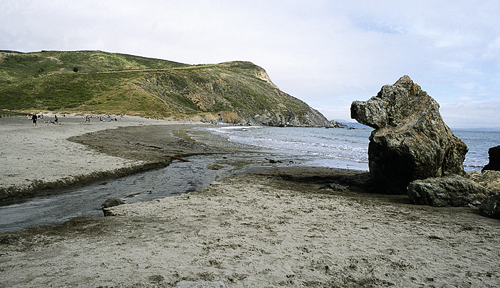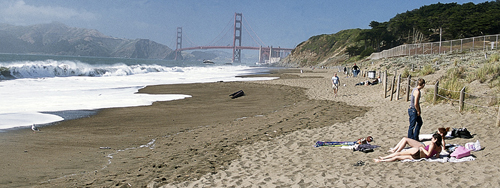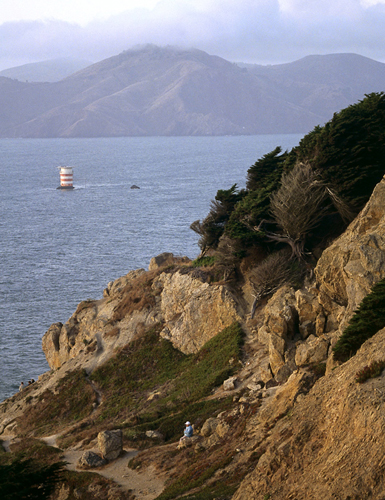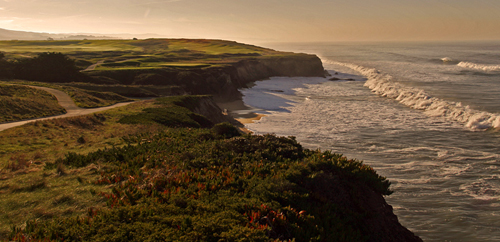Bolinas Beach This
hidden-away Marin beach tends to be windy and is mostly used by
dog-walkers, and kayakers. It’s sandy, with a backdrop of rocky cliffs.
If you walk north, you’ll find warmer nooks and crannies out of the
wind, where some sun-worshipers bask in the nude, although there is a
rarely enforced city ordinance against it . Stinson Beach Three
miles (5 km) of sand make this one of the most popular beaches in the
Bay Area, coupled with the fact that Marin often has fine weather when
the rest of the coast is covered in fog. As a result, it can be crowded
when the sun comes out . Muir and Red Rock Beaches These
two beaches, just south of Stinson, are the most famous nude beaches
north of San Francisco. Both are sandy curves within their own coves,
protected from wind and prying eyes by rocky cliffs. The only caveat is
that you’ll need sturdy walking shoes to get down the rough paths that
lead to them from the parking lots. Muir BeachRed Rock

Muir Beach
Baker Beach This
one-mile (1.5-km) stretch of sandy beach, with its perfect views of the
Golden Gate Bridge, is the most popular in the city. It’s great for
sunbathing, dog-walking, picnicking or jogging, but signs warn off
swimmers because of riptides. Sunsets here are unforgettable.

Baker Beach
China Beach Officially
called James D. Phelan Beach, this is the poshest beach in San
Francisco, being an adjunct to the exclusive Sea Cliff neighborhood.
Despite its pedigree, however, California law requires that all coastal
areas remain public, although access roads to them can be private. China
Beach is small and protected from the wind, there’s plenty of parking,
and it’s a pleasant walk down to the sand. Once there, you’ll find
showers and even changing rooms. Land’s End Although
extremely beautiful in a wild, untouched way, this tiny, rocky beach is
only for the hardiest nature-lovers. It’s quite a hike to get here,
although taking the trail up above it is quite a bit easier than going
by the lower, coastal trail. Many habitués have built little sun-traps
for themselves, by piling up rocks to wall-in their patches of sand.

Land’s End
Ocean Beach Some
4 miles (6.5 km) long and quite broad, this is the city’s largest beach
by far, but probably the worst for entering the water safely. It starts
at Cliff House and continues on beyond the city limits, turning into
picturesque dunes at the southern end. Great for walking or jogging, and
when the sun comes out, it’s a fine place to sunbathe . Half Moon Bay About
22 miles (35 km) south of the city, the Half Moon Bay shoreline forms a
long, gently curving sandy beach accessible at several points off
Highway 1. A horseback riding trail runs from Dunes Beach to the bluff
area of Francis Beach, and picnicking, kite-flying, surfing, and surf
fishing are popular activities.

Half Moon Bay
San Gregorio Beach Part
of San Gregorio Beach, 11.5 miles (18.5 km) south of Half Moon Bay, is
clothing-optional, but it requires a good hike down the cliffs to get
to. The entire stretch is partly state park, and includes a protected,
driftwood-strewn estuary at the back of a wide, sandy beach, with grassy
bluffs along the coast. All along there are protected areas and inlets.
The estuary is home to many birds and small animals. Pescadero Beach This
beach has a 1-mile (1.5-km) shoreline with sandy coves, rocky cliffs,
tide pools, surf-fishing spots, and picnic facilities. Across the
highway is Pescadero Marsh Natural Preserve, a popular area for
bird-watchers and other naturalists, being a refuge for blue heron,
kites, deer, raccoons, foxes and skunks. The beach is 14.5 miles (23.3
km) south of Half Moon Bay on Highway 1 .
|